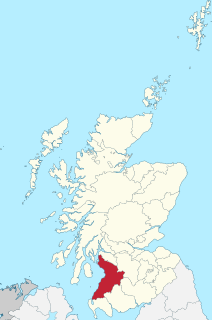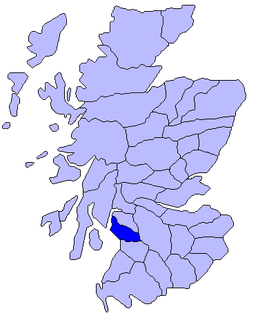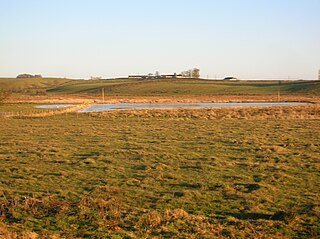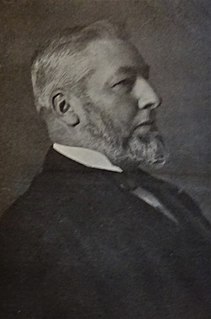The Maak's or Monk's Well is situated beside the Carmel Water in Kilmaurs, East Ayrshire. (NS 4114 4112), Scotland. A possible 'Holy Well', it was once a public water supply for the villagers and residents of the old castle at Kilmaurs Place. [1]
The Maak's or Monk's Well is situated beside the Carmel Water in Kilmaurs, East Ayrshire. (NS 4114 4112), Scotland. A possible 'Holy Well', it was once a public water supply for the villagers and residents of the old castle at Kilmaurs Place. [1]
The Maak's, Mack's or Monk's Well's waters once ran into the Carmel Water beneath Kilmaurs Place within the Morton Park, Kilmaurs. Originally it may have supplied the residents of Kilmaurs Place. [1]
The well is mentioned as being a source of water for the village in 1709 and 1831. [2] It was maintained as a public water supply using council funds. [3]
Famous for never drying up even in the driest summer, despite the great demands once placed upon it by the locals, in 2013 the well ceased running into the Carmel Water, possibly following damage incurred whilst new railings were being installed alongside path and the bank of the Carmel Burn. [1]

The source is now capped with a large stone slab (55.637669 -4.528186) and sits set into what is now the Kilmaurs Glencairn Bowling Club's boundary hedge. An underground pipe runs from the well to the wall of the Carmel Water from whence the overflow water once poured into the Carmel Water. [3]

The OS maps show that the Maak's ell was important enough to have direct prioritised pedestrian paths running to it from the north and west.
It is said that many years ago the local laird tried to prevent the local people from using the Maak's Well and it dried up until he changed his mind, but ran continuously until recent times. The laid had consulted the local priest who had advised "Restore the well to the people, let them come with their pitchers, and the waters will flow as yore." [4]
Stepping stones gave access from the other bank until a footbridge was built in 1824; stepping stones remained on the western approach for some time after. The local pronunciation is closer to 'Mank's well. [5]
It may have once been considered as having curative properties for in April 1709 it is recorded as having been administered to a sick woman although the result is not recorded. [3] In 1831 it was recorded as the 'Macks Well' and the name 'Monks' Well' is a corruption of the former although pronounced locally as 'Manks Well'. [3]
As stated, in 1824 a fine stone pedestrian bridge replaced the old stepping stones, however in 1825 the proprietors of the lands leading to the well tried to block access, even though this would have at one time been part of the common lands. The matter was fortunately settled with recourse to law. [3]
In the summer of 1826 the Carmel Water almost dried up, but the Maak's Well did not, and locals farmers brought their carts up the dry riverbed to collect water in barrels, etc. A horse bolted and the driver, a lady, hit her head against the bridge with such force that she was killed. [1] In 1843 two women crossing the bridge whilst carrying a heavy load between them fell into the Carmel and one was unfortunately drowned. [1]
In 1849 the burgh bailies requested that the Earl of Eglinton should help repair the road and embankment that led to the Maak's Well, adding that local tradition suggested that the path had been originally built by a 'religious establishment'. [1]
In 1879 David Landsborough describes the local wells and springs, including the Maak's Well. [6] John Smith in the 1890s [7] refers to the Monk's Well, however this may actually be a reference to the Lady's Well near the church.
In 1912 Duncan McNaught reported that thanks to the introduction of a 'gravitation water supply' the Maak's Well had recently been 'closed up'.

Ayrshire is a historic county and registration county in south-west Scotland, located on the shores of the Firth of Clyde. Its principal towns include Ayr, Kilmarnock and Irvine and it borders the counties of Renfrewshire and Lanarkshire to the north-east, Dumfriesshire to the south-east, and Kirkcudbrightshire and Wigtownshire to the south. Like many other counties of Scotland it currently has no administrative function, instead being sub-divided into the council areas of North Ayrshire, South Ayrshire and East Ayrshire. It has a population of approximately 366,800.

Cunninghame is a former comital district of Scotland and also a district of the Strathclyde Region from 1975 to 1996.

Kilmarnock and Loudoun was one of nineteen local government districts in the Strathclyde region of Scotland from 1975 to 1996.

Kilmaurs is a village in East Ayrshire, Scotland which lies just outside of the largest settlement in East Ayrshire, Kilmarnock. It lies on the Carmel Water, 21 miles southwest of Glasgow. Population recorded for the village in the 2001 Census recorded 2,601 people resided in the village It was in the Civil Parish of Kilmaurs.
Lambroughton is a village in the old Barony of Kilmaurs, Scotland. This is a rural area famous for its milk and cheese production and the Ayrshire or Dunlop breed of cattle.

Kerelaw Castle is a castle ruin owned by a surviving male descendant of the Hamilton family, Logan Neely. It is situated on the coast of North Ayrshire, Scotland in the town of Stevenston.
The village or hamlet of Gatehead is located in East Ayrshire, Parish of Kilmaurs, Scotland. It is one and a quarter miles from Crosshouse and one and a half miles from Kilmarnock. In the 18th and 19th centuries the locality was a busy coal mining district. The settlement runs down to the River Irvine where a ford and later a bridge was located.
Knockentiber is a village in East Ayrshire, Parish of Kilmaurs, Scotland. Knockentiber is two miles west-northwest of Kilmarnock and 1⁄2 mile northeast of Crosshouse. Latitude:55.6193°N Longitude:4.5455°W and grid reference NS397392. The population was 359 in 1991, however the population is much higher following the construction of several housing estates (2007). In the 18th and 19th and mid 20th centuries the locality was a highly industrialised coal mining district. The settlement is on the Carmel Burn, which runs into the River Irvine, around one mile to the south.

The River Irvine is a river that flows through southwest Scotland. Its watershed is on the Lanarkshire border of Ayrshire at an altitude of 810 feet (250 m) above sea-level, near Loudoun Hill, Drumclog, and 7 miles SW by W of Strathaven. It flows 29+1⁄2 mi (47.5 km) westward, dividing the old district of Cunninghame from that of Kyle, until it reaches the sea via Irvine Harbour in the form of the Firth of Clyde, and flows into Irvine Bay by the town of Irvine. It has many tributaries, some of which form parish, district and other boundaries.

Rowallan Castle is an ancient castle located in Scotland. The castle stands on the banks of the Carmel Water, which may at one time have run much closer to the low eminence upon which the original castle stood, justifying the old name Craig of Rowallan. Elizabeth Mure was mistress and then wife of Robert, High Steward of Scotland, and Guardian of Scotland, who later became King Robert II of Scotland. She may have been born at Rowallan.
Riccarton is a village and parish in East Ayrshire, Scotland. It lies across the River Irvine from Kilmarnock, this river forming the boundary between Riccarton and Kilmarnock parishes, and also between the historical districts of Kyle and Cunningham. The name is a corruption of 'Richard's town', traditionally said to refer to Richard Wallace, the uncle of Sir William Wallace. The parish also contains the village of Hurlford.
Kilmaurs Place, The Place or Kilmaurs House, is an old mansion house and the ruins of Kilmaurs Tower grid reference NS41234112 are partly incorporated, Kilmaurs, East Ayrshire, Scotland. The house stands on a prominence above the Carmel Water and has a commanding view of the surrounding area. Once the seat of the Cunningham Earls of Glencairn it ceased to be the main residence after 1484 when Finlaystone became the family seat. Not ot be confused with Kilmaurs Castle that stood on the lands of Jocksthorn Farm.

Kilmaurs Castle was located on the lands of Jocksthorn Farm, near Kilmaurs in East Ayrshire, Scotland. It is described by Timothy Pont in the early 17th century as "Ye castell is ane ancient ftronge building belonging to ye Earls of Glencairne environed with a fair park called Carmell wod from ye vatter of Carmell yat runs by it." Dobie goes on to state that "The old baronial manor place is supposed to have been situated about a mile south-east of Kilmaurs, where some ruins can still be pointed out on the farm of Jakisthorn or Jock's-thorn, probably the original Villam de Cuninghame - the first possession of the family." The castle is not to be confused with the later Cunninghame family possession known as Kilmaurs Place which Dobie calls "..comparatively modern" in 1876.

Busbie Castle was situated in what is now known as Knockentiber, a village in East Ayrshire, Parish of Kilmaurs, Scotland. Knockentiber is 2 miles (3.2 km) WNW of Kilmarnock and 1/2 mile NE of Crosshouse. The castle overlooked the Carmel Glen and its Burn, which runs into the River Irvine, a mile or so to the south, after passing through the old Busbie Mill.

Buiston Loch, also known as Buston, Biston, and Mid Buiston was situated in the mid-Ayrshire clayland at an altitude of 90 m OD. The loch was natural, sitting in a hollow created by glaciation. The loch waters drained via the Garrier Burn that joins the Bracken and Lochridge Burns before joining the River Irvine.
The old village or hamlet of Old Rome, Rome or Old Rome Ford is located in South Ayrshire, Parish of Dundonald, Scotland. It is one and a half miles from Crosshouse and one and less than a quarter of a mile from Gatehead. In the 18th and 19th centuries the locality was a busy coal mining district and many of the houses have been demolished. The settlement is situated near the River Irvine.

The Lands of Tour and Kirkland (NS416406) formed a small estate close to the old Kirktoun and St Maurs-Glencairn collegiate church about 1 km south-east of Kilmaurs, East Ayrshire, Parish of Kilmaurs, Scotland. The word 'Tour' in Scots refers to a 'tower' and 'kirk' to a parish church.

Bailliehill Mount, known locally as Bully Hill is a roughly circular earthwork associated with the Iron Age, located near the village of Kilmaurs in East Ayrshire, Scotland.

Duncan McNaught LL.D., J.P., was born in Alexandria, Dunbartonshire in 1845. He was the parochial school teacher at Kilmaurs in East Ayrshire from 1867 and served at the school for over fifty years, having served as assistant from 1865. He founded the Kilmarnock Conservative Association, jointly founded the Robert Burns World Federation, acted as the editor of the "Burns Chronicle" and was the president of what became the Robert Burns World Federation.

The Glencairn Aisle or Glencairn Vault at Kilmaurs, East Ayrshire is a vaulted sepulchral chapel built as a place for private contemplation and prayer that also contains a large memorial monument, as well as the burial crypt of the Cunningham Earls of Glencairn and their family members. It houses an exceptional ornately carved stone mural monument dated 1600 that commemorates James Cunningham, the 7th Earl of Glencairn, his countess, Margaret Campbell and eight of their children. It is the oldest such 'Glorious Tomb' monument built in the 17th century in Ayrshire and one of the oldest post-reformation monument in Scotland. The other Ayrshire examples being the Kennedy or Bargany Aisle at Ballantrae of circa 1601, the Skelmorlie Aisle at Largs of 1639, the Crauford Monument at Kilbirnie and the Hamilton Aisle at Dunlop of 1641.
Coordinates: 55°38′2.2″N4°31′10.7″W / 55.633944°N 4.519639°W